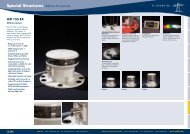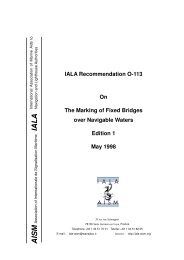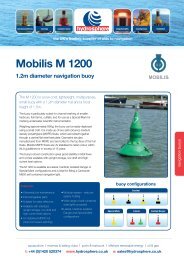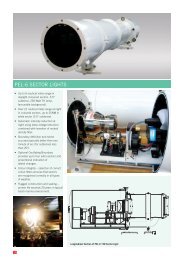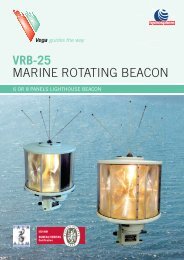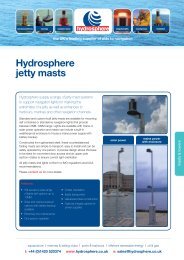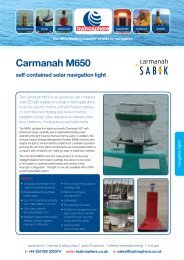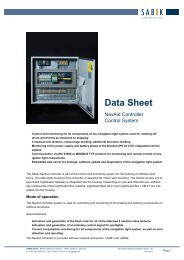(R-101) on Marine Radar Beacons (Racons) - Hydrosphere UK Ltd.
(R-101) on Marine Radar Beacons (Racons) - Hydrosphere UK Ltd.
(R-101) on Marine Radar Beacons (Racons) - Hydrosphere UK Ltd.
Create successful ePaper yourself
Turn your PDF publications into a flip-book with our unique Google optimized e-Paper software.
AISM Associati<strong>on</strong> Internati<strong>on</strong>ale de Signalisati<strong>on</strong> Maritime IALA Internati<strong>on</strong>al Associati<strong>on</strong> of <strong>Marine</strong> Aids to Navigati<strong>on</strong> and Lighthouse Authorities<br />
Recommandati<strong>on</strong> sur les balises radars<br />
maritimes (Rac<strong>on</strong>s)<br />
(traducti<strong>on</strong> française en cours)<br />
Recommendati<strong>on</strong> <strong>on</strong> <strong>Marine</strong> <strong>Radar</strong> Beac<strong>on</strong>s<br />
(Rac<strong>on</strong>s)<br />
20ter, rue Schnapper – 78100 Saint Germain en Laye – France<br />
Teleph<strong>on</strong>e : +33 1 34 51 70 01 Telefax : +33 1 34 51 82 05<br />
E-mail : aismiala@easynet.fr Internet : http://www.iala-aism.org<br />
IALA Recommendati<strong>on</strong> R-<str<strong>on</strong>g>101</str<strong>on</strong>g>r1<br />
December 2000
Introducti<strong>on</strong><br />
<strong>Radar</strong> beac<strong>on</strong>s (rac<strong>on</strong>s), when used with a ship’s radar, form a sec<strong>on</strong>dary navigati<strong>on</strong> aids<br />
system.<br />
This Recommendati<strong>on</strong> supercedes IALA Recommendati<strong>on</strong> R-<str<strong>on</strong>g>101</str<strong>on</strong>g>, "IALA<br />
Recommendati<strong>on</strong> <strong>on</strong> <strong>Marine</strong> <strong>Radar</strong> Beac<strong>on</strong>s (Rac<strong>on</strong>s)", dated 1 st January 1995.<br />
This Recommendati<strong>on</strong>, which takes account of ITU-R Recommendati<strong>on</strong> M.824-2,<br />
Technical Parameters for <strong>Radar</strong> Beac<strong>on</strong>s (Rac<strong>on</strong>s), c<strong>on</strong>tains two parts and <strong>on</strong>e annex:<br />
Part 1 specifies the minimum technical characteristics for general-purpose rac<strong>on</strong>s.<br />
These technical characteristics are similar to those set out in Annex 1 to ITU-R<br />
Recommendati<strong>on</strong> M.824-2 and include:<br />
1. Antenna polarizati<strong>on</strong> which has been specified with reference to the<br />
interrogating radar characteristics;<br />
2. The frequency tolerances which reflect current technology; and,<br />
3. The durati<strong>on</strong> of the resp<strong>on</strong>se.<br />
Part 2 c<strong>on</strong>tains guidance <strong>on</strong> the use of rac<strong>on</strong>s;<br />
Annex A is the document “IALA Guidelines <strong>on</strong> Rac<strong>on</strong> Range Performance”.
THE COUNCIL<br />
NOTING that the Internati<strong>on</strong>al Maritime Organizati<strong>on</strong>, in Assembly Resoluti<strong>on</strong> A.615(15) <strong>on</strong><br />
"<strong>Radar</strong> Beac<strong>on</strong>s and Transp<strong>on</strong>ders", has recommended operati<strong>on</strong>al standards for radar beac<strong>on</strong>s;<br />
NOTING FURTHER that the Internati<strong>on</strong>al Telecommunicati<strong>on</strong> Uni<strong>on</strong> in ITU - R<br />
Recommendati<strong>on</strong> M.824-2 gives the technical characteristics of a general purpose maritime<br />
radar beac<strong>on</strong>;<br />
RECOGNISING that many Aids to Navigati<strong>on</strong> Authorities have installed maritime radar<br />
beac<strong>on</strong>s as general purpose aids to navigati<strong>on</strong>;<br />
HAVING CONSIDERED the proposals made by the IALA Radi<strong>on</strong>avigati<strong>on</strong> Committee;<br />
RECOMMENDS:<br />
a) That radar beac<strong>on</strong>s (rac<strong>on</strong>s) provided by Aids to Navigati<strong>on</strong> Authorities should c<strong>on</strong>form to<br />
the technical characteristics set out in Part 1 of this recommendati<strong>on</strong>.<br />
b) That Aids to Navigati<strong>on</strong> Authorities take into account the guidelines <strong>on</strong> the use of rac<strong>on</strong>s<br />
set out in Part 2 of this Recommendati<strong>on</strong> when establishing rac<strong>on</strong> sites.<br />
c) That Aids to Navigati<strong>on</strong> Authorities take into account the Guidelines <strong>on</strong> Rac<strong>on</strong> Range<br />
Performance set out in Annex A of this Recommendati<strong>on</strong>.
Part 1<br />
Technical Parameters for a General Purpose<br />
Maritime <strong>Radar</strong> Beac<strong>on</strong> (Rac<strong>on</strong>)<br />
Table 1<br />
From ITU-R M.824-2 Annex 1<br />
Item<br />
Specificati<strong>on</strong>s<br />
1 Antenna Polarizati<strong>on</strong> In the 9 GHz band, suitable for resp<strong>on</strong>ding to radars using horiz<strong>on</strong>tal<br />
polarizati<strong>on</strong>.<br />
2 Receiver 1 Frequency band<br />
2 Blocking period<br />
3 Primary radar pulse length<br />
In the 3 GHz band, suitable for resp<strong>on</strong>ding to radars using horiz<strong>on</strong>tal polarizati<strong>on</strong><br />
and to radars using vertical polarizati<strong>on</strong><br />
9 300 - 9 500 MHz and/ or 2 900 - 3 100 MHz.<br />
(9 300 – 9 320 from 01 January 2001)<br />
100 µs after end of resp<strong>on</strong>se.<br />
0.05 µs.<br />
3 Transmitter Frequency Transmissi<strong>on</strong> should occur either:<br />
<strong>on</strong> the frequency of the interrogating signal with a frequency tolerance of ± 3.5<br />
MHz for interrogating pulses with a durati<strong>on</strong> of less than 0.2 µs, or , with a<br />
frequency tolerance of ± 1.5 MHz for pulses with a durati<strong>on</strong> equal to or more<br />
than 0.2 µs,<br />
or by a series of sweeps covering the entire frequency band of the receiver in<br />
which the signal was received. Where the transmissi<strong>on</strong> c<strong>on</strong>sists of a series of<br />
sweeps, the form of the sweep shall be sawtooth and should have a slew rate<br />
of between 60 s and 120 s per 200 MHz.<br />
4 Resp<strong>on</strong>se 1 Delay after receipt of<br />
interrogati<strong>on</strong><br />
2 Form of<br />
identificati<strong>on</strong><br />
Normally not more than 0.7 µs.<br />
Identificati<strong>on</strong> coding should normally be in the form of a Morse letter. The<br />
identificati<strong>on</strong> coding used should be as described in appropriate navigati<strong>on</strong>al<br />
publicati<strong>on</strong>s.<br />
The identificati<strong>on</strong> coding should comprise the full length of the radar beac<strong>on</strong><br />
resp<strong>on</strong>se and, where a Morse letter is used, the resp<strong>on</strong>se should be divided with<br />
a ratio of <strong>on</strong>e dash equal to three dots and <strong>on</strong>e dot equal to <strong>on</strong>e space. The<br />
coding should normally commence with a dash.<br />
3 Durati<strong>on</strong><br />
The durati<strong>on</strong> of the resp<strong>on</strong>se should be approximately 20% of the maximum<br />
range requirement of the particular radar beac<strong>on</strong>, or should not exceed five<br />
miles, whichever is the lower value. In certain cases, the durati<strong>on</strong> of the<br />
resp<strong>on</strong>se may be adjusted to suit the operati<strong>on</strong>al requirements for the particular<br />
radar beac<strong>on</strong> (see Note 1)<br />
Note 1: Characteristics for antenna aperture and gain, receiver sensitivity, transmitter power, rac<strong>on</strong><br />
resp<strong>on</strong>se durati<strong>on</strong>, rac<strong>on</strong> ON period/ OFF period, and side-lobe suppressi<strong>on</strong> should be determined by<br />
Authorities.<br />
Note 2:<br />
Note 3:<br />
Swept frequency rac<strong>on</strong>s are obsolescent and are not recommended for new installati<strong>on</strong>s.<br />
Power output is not specified. Please see Annex A for a discussi<strong>on</strong> of rac<strong>on</strong> signal strength.
Part 2<br />
Guidelines <strong>on</strong> the use of Rac<strong>on</strong>s<br />
These guidelines have been prepared by IALA to assist Authorities c<strong>on</strong>sidering the provisi<strong>on</strong> of rac<strong>on</strong>s<br />
or the replacement of existing devices.<br />
1. Rac<strong>on</strong>s should c<strong>on</strong>form to Table 1.<br />
2. Rac<strong>on</strong>s operating <strong>on</strong> both 9 GHz and 3 GHz bands should normally be provided.<br />
3. To avoid unnecessary radar screen clutter, rac<strong>on</strong>s should be programmed with OFF periods. To<br />
prevent processing circuits in radars from rejecting the rac<strong>on</strong> signal, ON periods should be no less<br />
than fifteen sec<strong>on</strong>ds. To maintain an adequate update rate <strong>on</strong> the display, there should be at least<br />
<strong>on</strong>e ON period in every sixty sec<strong>on</strong>ds, unless there are special operating requirements.<br />
4. Rac<strong>on</strong>s should be fitted with side-lobe suppressi<strong>on</strong>.<br />
5. Coding of rac<strong>on</strong>s should be in accordance with internati<strong>on</strong>al recommendati<strong>on</strong>s (Ref. IMO<br />
Resoluti<strong>on</strong> A.615(15)).<br />
6. Rac<strong>on</strong>s emit microwave radiati<strong>on</strong>. Installati<strong>on</strong> and service pers<strong>on</strong>nel should be properly trained for<br />
working with microwave equipment. Authorities should ensure that the rac<strong>on</strong> installati<strong>on</strong> is safe<br />
according to local laws. However, it should be noted that a rac<strong>on</strong>’s effective radiated power is quite<br />
low and that safe installati<strong>on</strong>s usually do not require any special effort.<br />
2.1 gives the most suitable applicati<strong>on</strong>s for rac<strong>on</strong>s;<br />
2.2 is a Glossary of Terms; and,<br />
Annex A gives guidance <strong>on</strong> ranges of 9 GHz and 3 GHz rac<strong>on</strong>s.
2.1 Guidance <strong>on</strong> the Applicati<strong>on</strong>s of Rac<strong>on</strong>s<br />
2.1.1 General<br />
Swept frequency rac<strong>on</strong>s are now obsolescent.<br />
For frequency agile rac<strong>on</strong>s, the power output is part of the rac<strong>on</strong>´s design and cannot be changed. In<br />
some cases the antenna characteristics can be selected, for example a higher gain antenna can be used<br />
for l<strong>on</strong>ger range. Other characteristics (some of Table 1, Note 1) can usually be adjusted for individual<br />
rac<strong>on</strong>s. The siting of a rac<strong>on</strong> must take into account the required range performance (see Annex A).<br />
2.1.1.1 Inland Waterways<br />
Rac<strong>on</strong>s used <strong>on</strong> inland waterways have applicati<strong>on</strong>s similar to coastal rac<strong>on</strong>s, and are not c<strong>on</strong>sidered<br />
separately here, although the settings for the two uses may be different. However, it should be noted<br />
that, at the present time, 9 GHz band radars are the types normally used <strong>on</strong> inland waterways.<br />
2.1.1.2 Floating Aids<br />
When a rac<strong>on</strong> is fitted to a floating aid, various factors such as the moti<strong>on</strong>, available electrical power,<br />
mounting height, and size and weight c<strong>on</strong>straints need to be c<strong>on</strong>sidered. An omnidirecti<strong>on</strong>al antenna<br />
with a broad vertical beamwidth is required.<br />
2.1.1.3 Frequency Bands<br />
Although most vessels have radars that operate in the 9 GHz band, an increasing number are fitted with<br />
both 9 GHz and 3 GHz band radars. The provisi<strong>on</strong> of dual band rac<strong>on</strong>s is important, since at times,<br />
particularly during bad weather, many vessels use 3 GHz band radars in preference to 9 GHz band<br />
radars because the former produce better clutter rejecti<strong>on</strong>. A vessel equipped with a radar for each band<br />
will tend to use the <strong>on</strong>e that produces the better display in any given situati<strong>on</strong>. Therefore rac<strong>on</strong> service<br />
will be expected to be available at all times in both the 3 GHz and 9 GHz bands.<br />
2.1.2 Specific applicati<strong>on</strong>s<br />
The following specific applicati<strong>on</strong>s of rac<strong>on</strong>s are c<strong>on</strong>sidered.<br />
2.1.2.1 L<strong>on</strong>g Range Navigati<strong>on</strong><br />
A rac<strong>on</strong> can be used to identify a navigati<strong>on</strong> mark at l<strong>on</strong>g range.<br />
2.1.2.2 Landfall<br />
A rac<strong>on</strong> can be sited to enhance the resp<strong>on</strong>se of a mark that is the first to be seen during an approach<br />
from the open sea to a part of the coast.<br />
2.1.2.3 Inc<strong>on</strong>spicuous Coastline Marking<br />
A rac<strong>on</strong> can be mounted near the shore to mark a coastline that has no significant features or is difficult<br />
to distinguish or identify <strong>on</strong> a radar display.
2.1.2.4 Short Range Navigati<strong>on</strong><br />
A short-range rac<strong>on</strong> can be used to identify a local feature of interest (e.g. a harbour entrance).<br />
2.1.1.5 Leading Line<br />
Two rac<strong>on</strong>s, or a rac<strong>on</strong> and radar reflector, separated by an adequate distance, can be used to define a<br />
leading line <strong>on</strong> a radar display. A vessel using the leading line can then follow an accurate course even<br />
in poor visibility.<br />
2.1.2.6 New Danger<br />
A rac<strong>on</strong> can be used to mark a new danger, such as a wreck. When a rac<strong>on</strong> is used in this way it should<br />
be coded with the Morse letter "D" and show a signal length of <strong>on</strong>e nautical mile <strong>on</strong> the radar display.<br />
2.1.2.7 Bridge Marking<br />
A rac<strong>on</strong> can be used to indicate the navigable channel under a bridge by placing it above the centre of<br />
the fairway (IALA Recommendati<strong>on</strong> 14 May 1987).<br />
Although bridges crossing fairways are usually clearly recognizable <strong>on</strong> a radar display, channel<br />
boundaries or bridge piers are seldom displayed so clearly. Rac<strong>on</strong>s, shielded to provide directi<strong>on</strong>al<br />
resp<strong>on</strong>ses, can also be provided to mark traffic separati<strong>on</strong> lanes between bridge piers.<br />
2.1.2.8 Offshore structures<br />
A rac<strong>on</strong> can be fitted where there is a requirement to identify a particular offshore structure. The<br />
relevant authority will determine its range and code. Any rac<strong>on</strong> <strong>on</strong> a temporary uncharted structure<br />
shall be coded with the Morse letter "D" and show a signal length of <strong>on</strong>e nautical mile <strong>on</strong> the radar<br />
display.<br />
2.1.2.9 Routing Schemes<br />
A rac<strong>on</strong> can be used in a traffic routing scheme, or to mark an area to be avoided.<br />
2.1.2.10 Turning Mark<br />
A rac<strong>on</strong> can be used to c<strong>on</strong>trol the radius of a turn by keeping it at a fixed range during the manoeuvre.<br />
2.1.3 Envir<strong>on</strong>ment<br />
The envir<strong>on</strong>ment in which a rac<strong>on</strong> operates will also affect its usefulness in the following ways.<br />
2.1.3.1 Normal Envir<strong>on</strong>ment<br />
In this situati<strong>on</strong> the rac<strong>on</strong> can be expected to perform in accordance with the parameters set out in IMO<br />
Resoluti<strong>on</strong> A.615(15).
2.1.3.2 Sea Clutter Masking 1<br />
This effect is variable and depends <strong>on</strong> the sea c<strong>on</strong>diti<strong>on</strong>s and the height of the radar antenna. The<br />
resp<strong>on</strong>se from a rac<strong>on</strong> can be obscured by radar returns from the waves in the sea.<br />
2.1.3.3 Land and Pack Ice Masking 1<br />
Land or pack ice near a rac<strong>on</strong> can cause sufficient clutter to mask a rac<strong>on</strong> resp<strong>on</strong>se. Pack ice can also<br />
distort the appearance of a shoreline <strong>on</strong> a radar display.<br />
2.1.3.4 Target Masking in C<strong>on</strong>gested Waterways 1<br />
Under certain c<strong>on</strong>diti<strong>on</strong>s, in busy waterways, rac<strong>on</strong> resp<strong>on</strong>ses may mask important radar targets.<br />
2.1.4 Characteristics<br />
2.1.4.1 Effective Sensitivity and Effective Radiated Power<br />
The radar detecti<strong>on</strong> range of a rac<strong>on</strong> can be increased or decreased by changing the effective sensitivity<br />
or effective radiated power of the rac<strong>on</strong>. Higher effective radiated power of the rac<strong>on</strong> can improve the<br />
probability of detecti<strong>on</strong> by a radar in clutter c<strong>on</strong>diti<strong>on</strong>s. An increase in the rac<strong>on</strong> antenna gain increases<br />
the effective sensitivity and the effective radiated power. As a c<strong>on</strong>sequence there may be reducti<strong>on</strong>s in<br />
the vertical and horiz<strong>on</strong>tal beam widths of the rac<strong>on</strong> antenna.<br />
2.1.4.2 Sidelobe suppressi<strong>on</strong><br />
A vessel passing a rac<strong>on</strong> at close range, perhaps 0.5 nautical miles or less may trigger the rac<strong>on</strong> with the<br />
radar antenna sidelobes, hence causing interference <strong>on</strong> the radar display. Sidelobe interference can be<br />
suppressed by special rac<strong>on</strong> circuitry. The rac<strong>on</strong> identifies the str<strong>on</strong>gest signal as being from the main<br />
lobe and suppresses the rest.<br />
2.1.4.3 Energy C<strong>on</strong>sumpti<strong>on</strong><br />
Energy c<strong>on</strong>sumpti<strong>on</strong> is a feature of the rac<strong>on</strong> design, but can be reduced, to some extent, by decreasing<br />
the ON period to OFF period ratio.<br />
2.1.4.4 Update Rate<br />
The rate at which the resp<strong>on</strong>se from a rac<strong>on</strong> is updated <strong>on</strong> the radar display is determined by the ON<br />
period/ OFF period ratio of the rac<strong>on</strong> resp<strong>on</strong>se and the rotati<strong>on</strong>al rate of the radar antenna.<br />
2.1.4.5 Coding<br />
Identificati<strong>on</strong> should take the form of a Morse code letter. The letter should normally be <strong>on</strong>e with an<br />
initial dash and not more than three dots or dashes. To c<strong>on</strong>form to the Morse code structure, <strong>on</strong>e dash<br />
should equal the sum of three dots, with <strong>on</strong>e dot equal to <strong>on</strong>e space.<br />
1 Improved siting of rac<strong>on</strong>s and/or selecti<strong>on</strong> of an appropriate ON period/ OFF period ratio may provide<br />
soluti<strong>on</strong>s to these problems.
Groups of equally spaced dots are used as identificati<strong>on</strong> codes for search and rescue transp<strong>on</strong>ders (IMO<br />
Resoluti<strong>on</strong> A.530(13)), and therefore they should not be used as identificati<strong>on</strong> codes for rac<strong>on</strong>s.
2.2 Glossary of terms<br />
<strong>Radar</strong> Beac<strong>on</strong> (Rac<strong>on</strong>)<br />
"A transmitter receiver device associated with a fixed navigati<strong>on</strong>al mark which when triggered by a<br />
radar, automatically returns a distinctive signal which can appear <strong>on</strong> the display of the triggering radar,<br />
providing range, bearing and identificati<strong>on</strong> informati<strong>on</strong>." (ITU Radio Regulati<strong>on</strong> 4.40).<br />
The terms 'radar beac<strong>on</strong>' and 'rac<strong>on</strong>' should be reserved exclusively for this use. Rac<strong>on</strong>s may be<br />
devices mounted <strong>on</strong> fixed structures, or <strong>on</strong> floating aids anchored at fixed positi<strong>on</strong>s, for navigati<strong>on</strong>al<br />
purposes. Whether used al<strong>on</strong>e or mounted <strong>on</strong> another aid to navigati<strong>on</strong> (such as a visible mark) the<br />
rac<strong>on</strong> itself is c<strong>on</strong>sidered a separate aid to navigati<strong>on</strong>. (IMO Resoluti<strong>on</strong> A.615 (15)).<br />
Frequency-Agile Rac<strong>on</strong><br />
A rac<strong>on</strong> which replies at the frequency of the interrogating radar.<br />
Slow-Sweep Rac<strong>on</strong><br />
A rac<strong>on</strong> in which the transmitter is c<strong>on</strong>tinuously swept over the particular radar band and resp<strong>on</strong>ds<br />
when interrogated. The update rate is 60 to 150 sec<strong>on</strong>ds.<br />
Update Rate<br />
The rate at which the rac<strong>on</strong> reappears <strong>on</strong> a radar display.<br />
Side-Lobe Suppressi<strong>on</strong><br />
The means by which a rac<strong>on</strong> is inhibited from transmitting in resp<strong>on</strong>se to a signal from a side lobe of<br />
the antenna of an interrogating radar.
ANNEX A – Text of “IALA Guidelines <strong>on</strong> Rac<strong>on</strong> Range Performance”


